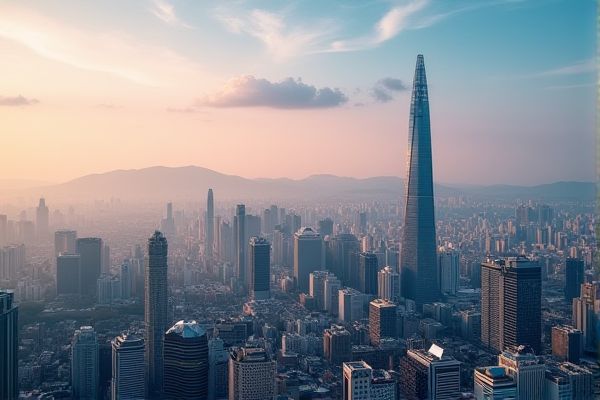
Weather and climate in South Korea: Four distinct seasons. Hot, humid summers. Cold, snowy winters. Mild spring temperatures. Colorful autumn foliage. Heavy monsoon rains (June-August). Occasional typhoons. Air pollution concerns. Frequent fluctuating temperatures. Winter heating practices.
Four distinct seasons.
South Korea has four distinct seasons: spring is cool with occasional cold snaps and yellow dust storms; summer is hot, humid, and rainy with heavy precipitation during the East Asian monsoon; autumn is clear and mild; and winter is cold and dry, influenced by the Siberian high-pressure system. For more in-depth information about these seasonal changes, you can explore the Weather In South Korea on the Statista website.
Hot, humid summers.
South Korea experiences hot and humid summers, with the average summer temperature in 2024 reaching a record 25.6 degrees Celsius (78.08 Fahrenheit), significantly higher than the historical average. The season is marked by high humidity, prolonged heat waves, and tropical nights, alongside significant rainfall during the Changma monsoon season from late June to late July. For more details on this climatic phenomenon, you can refer to the detailed report on South Korea's Heatwave, which captures the atmospheric dynamics and its implications on the region. As South Korea continues to grapple with rising temperatures, these conditions could have profound impacts on agriculture, health, and overall quality of life.
Cold, snowy winters.
South Korea's winters, from December to March, are characterized by freezing cold and relatively dry conditions, with crisp snow creating romantic landscapes. The northern regions, such as Gangwon-do Province, can experience temperatures as low as -20°C, while the southern coast and Jeju Island are milder. This makes the north-east a popular area for winter sports like skiing and snowboarding. For more detailed information on the country's seasonal changes, visit the Selective Asia website.
Mild spring temperatures.
In April, South Korea experiences mild spring temperatures, with low rainfall and the blossoming of cherry blossoms, making it a popular time to visit. Temperatures range from a minimum of 6°C to a maximum of 13°C, especially in southern areas like Busan and Jeju Island, although it can still be chilly in mountainous regions and Seoul. For more details, visit the Selective Asia website for an in-depth weather guide to South Korea in April.
Colorful autumn foliage.
This year's autumn foliage in South Korea has faced a delay as a result of higher-than-average temperatures in September, pushing the peak foliage date to around October 23rd. This is later compared to last year's peak on October 17th. Interestingly, this delay forms part of a consistent trend observed over the past few years, which experts attribute to the persistent rise in temperatures. For more insights on this beautiful season, you can explore the details on Autumn Foliage Korea. Observing the natural shifts in Korea's landscape offers a fascinating glimpse into how climate patterns are influencing seasonal changes.
Heavy monsoon rains (June-August).
South Korea experiences heavy monsoon rains from June to August, with these months accounting for more than half of the country's annual rainfall. The period is characterized by high temperatures, very high humidity, and the possibility of typhoons and landslides, especially in hilly areas. For more detailed information on the seasonal climate and what to expect, you might find the insights on Selective Asia's website valuable.
Occasional typhoons.
South Korea experiences occasional typhoons, primarily from July to September, which are intensified by warmer ocean waters and a moister atmosphere, leading to powerful storms and significant rainfall, particularly in the southern parts of the peninsula. These climatic changes are explored in depth on the Climate Reality Project website, shedding light on the broader implications of the climate crisis in the region and beyond.
Air pollution concerns.
Air pollution in South Korea, particularly in the Seoul metropolitan region, has been a significant concern due to high emissions from transport, industry, and other economic activities. Despite decades of government efforts and substantial investments in air quality management, including robust legal frameworks and emission reduction policies, the region still grapples with pollution, especially from fine dust (PM2.5) and other pollutants, many of which originate from China and domestic sources. For more insight on how the Greater Seoul area is dealing with smog issues, the United Nations Environment Programme provides a comprehensive view of ongoing efforts and challenges.
Frequent fluctuating temperatures.
South Korea is experiencing frequent fluctuations in temperatures, with average temperatures rising by about 1.5 degrees Celsius in the last century, leading to more extreme heat during summers and fewer cold days in winters. This change in climate conditions has resulted in an increased frequency of extreme weather events such as typhoons, heavy rains, and droughts. For further insights into these environmental shifts, you can visit the Climate Reality Project which provides a comprehensive analysis of how the climate crisis is impacting South Korea.
Winter heating practices.
In South Korea, winter heating primarily relies on the traditional Ondol system, an in-floor heating system often powered by a boiler using gas or electricity. To prevent damage, it is crucial to use the 'leave' mode on boilers to maintain a temperature between 19-20°C, close windows, and take special care of unheated areas such as utility rooms and bathrooms. For more detailed information on how to effectively prepare your home for the cold season, check out the expert advice provided on Winterize Your Korean Home.
